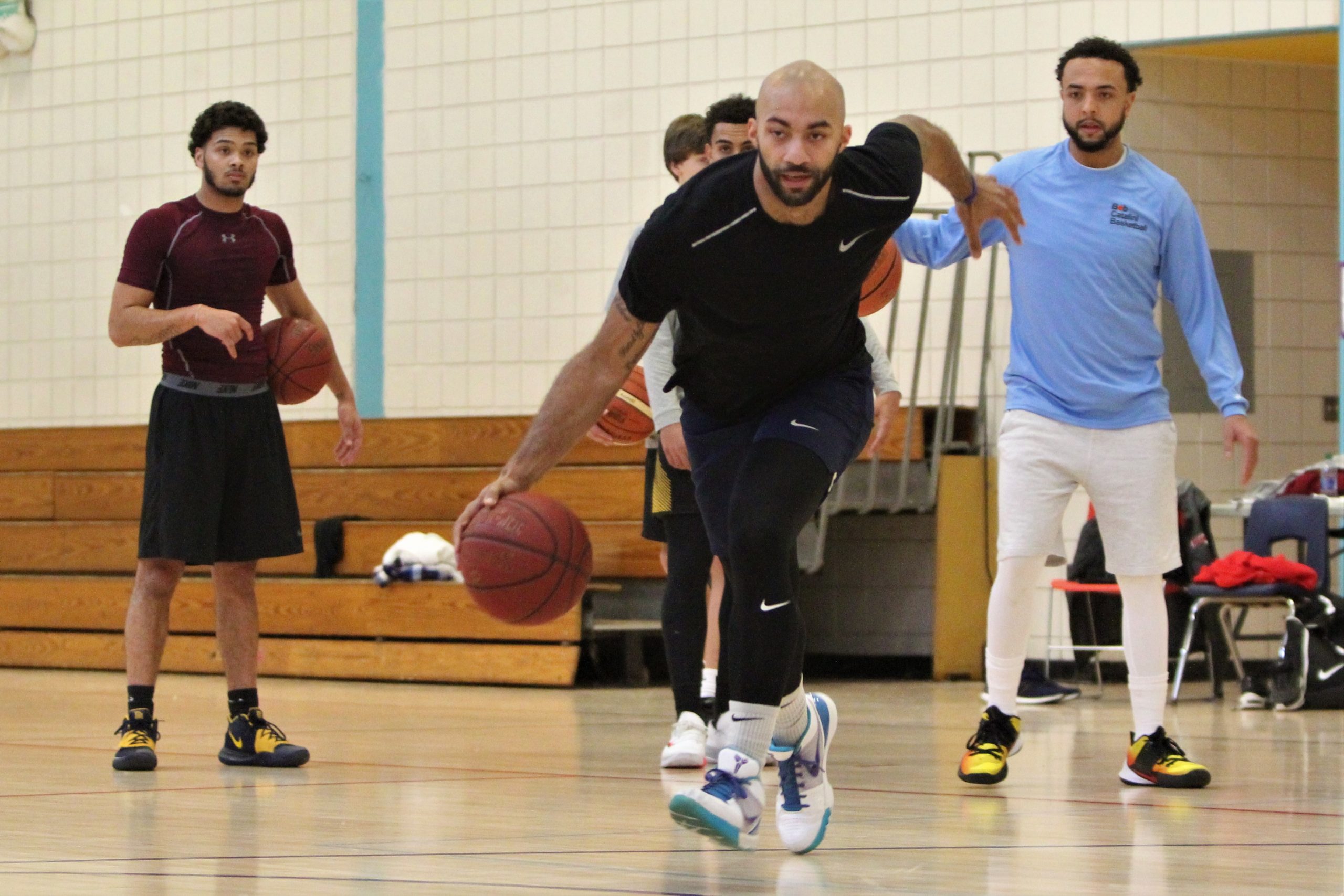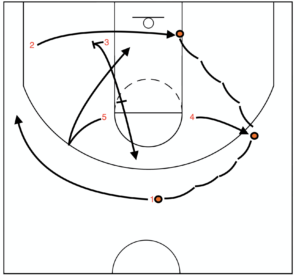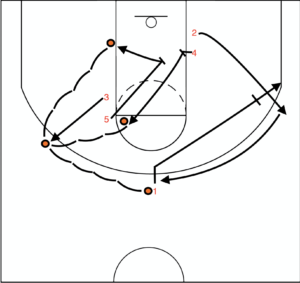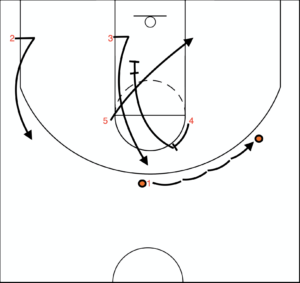Integrating the ‘Screen & Re-screen’ Action
Previous articles have discussed the various types of screens and their degrees of difficulty that opposing defenses have in defending them. When offenses include in their overall offensive package different types of screens, their offensive arsenal becomes even more potent. But when offenses then find ways to create plays or entries or other ways that can allow offensive players to then set a second screen (whether it is the same type of screen or a different type) makes that play even tougher to defend.
If a team has one or more players that are valuable as defenders, rebounders, or passers but are limited in their overall scoring skills; those offensive players can still contribute to the offense by setting different types of solid screens that will free up the team’s more elite scorers. Giving that type of player more weapons and opportunities to contribute by setting more than one screen in a play makes that player a more productive player.

A creative coach can then devise plays that allow players to highlight their offensive skills, whether those skills are dribbling, passing, shooting, or posting up. That same innovative coach can create plays that provide that ‘good screener’ in different ways and different combinations of screens that can be successfully set in the framework of the offense.
If 03 is the hypothetical “non-scorer,” Play #1 could be executed so that 03 can still contribute to the offense—as a screener and re-screener. Play #1 is shown being executed out of the “3-OVER” Set. This set is overloaded on the left side in the diagram, but 03 and 02 could start on the right side of the offense as well. This play dictates that the post player opposite of 03 and 02’s side to be the designated player to pop out just outside of the 3 point arc when 01 gets close enough to him. The initial alignment as well as 04’s pop-out truly inverts the post players out on the perimeter, which pulls the defense’s ‘bigs’ also out away from the basket. This creates an unprotected basket for the offensive team to attack in a variety of ways, such as inverting perimeter players inside.

As 01 makes the pass to 04, 02 makes a hard cut along the baseline before then making a “Flex-Cut” off of 03’s back-screen; all the while looking to receive 04’s inside pass. As soon as 02 scrapes off of 03, 03 then steps up to set a ‘Small-on-Big’ Back-Screen for 05 to use as he then makes a ‘Lob-Cut’ to the basket. As soon as 01 makes the pass to 04, he flare-cuts and looks for a possible ‘skip-pass’ from 04. This action pulls X1 out of the middle of the floor and allows 03 to then step up to the top of the key and somewhat occupies potential help-side defenders from getting involved in helping the inverted defender (X2) in his uncomfortable isolated defensive post-up situation. Even if 03 is not a shooting threat at the top of the key, 03 has contributed by setting two types of screens for two different players. If 04 turns down the inside pass to 02 for some reason, 03 can then become the “relay” player that can receive 04’s reverse pass for the offense to then attack the opposite side of the floor. This places all five offensive players in the “3-Out/2-In” Spot-Ups for the offense to be able to smoothly convert from one phase to the next phase of attack. See Diagram 01.
Play #2 is executed out of the “HI-LO STAX” Set. Diagram 02 has 05 and 03 align up as the “high stack” on their left side of the floor with 04 & 02 aligning as the “low stack” on their right side of the floor. Players05 and 03 could become the “low stack” on the left side and 04 & 02 could form the “high stack” on the right side of the floor.

Players 05 and 04 both set ‘big-on-small’ pin-screens for 03 and 02 respectively. Player 01 could make the wing pass to either wing player, with that player’s “pin-screener” then cutting across the lane diagonally to set a Lane Exchange (Diagonal) Screen for the opposite side’s post player and then sealing off that defender and flashing back to the ball. Diagram 02 has 01 pass the ball to 03. Player 05 then sets the interior screen for 04 to use as he flashes to the new ball-side high post. After setting his second screen, 05 then flashes back to the new ball-side mid-post block. Player 01 makes his wing pass and then screens the opposite wing player (02). See Diagram 02.

Receiving 01’s wing pass, 03 first looks to hit 04 flashing to the high post, then to 05 on the new ball-side mid-post. Player 03 could make a reverse pass to 02 or a skip pass to 01. If the ball is reversed to 02 and 02 does not take the shot, 03 can then shuffle-cut off of 04’s high-post back-screen or off of 04’s low-post back-screen and then on through the lane to post up on the new ball-side mid-post. If 02 does not hit 03, 02 swings the ball to 01 on the new ball-side wing. Player 02 then immediately goes with 04 to set a stagger-screen for 05 to use as he breaks up to the (now vacant) top of the key, looking for 01’s pass. If 03 cuts off of 05’s back-screen, 02 and 04 then set a stagger-screen for 05 to use. This can be a form of (stagger-)screen the (back-)screener. Player 01’s first option is to hit 03 posting up his perimeter-type defender on the new ball-side mid-post block. Player 01’s second option is to make the pass to 05 at the top of the key. If that ‘3 pt.’ shot at the top of the key is out of 05’s range, the stagger-screen at least helps eliminate help-side defense that X3 needs to adequately defend 03. If 05 is open but is not a shooting threat; the reverse pass from 01 to 05 ends the play with all players in the proper “3-Out/2-In” Spot-Ups so that one phase of the offensive attack is over with the next phase ready to smoothly begin. See Diagram 03.

Play #3 can be executed out of the “3-OVER” Set. Players 02 and 03 could move over to the right side of the court to change the cosmetic appearance of this set, but for this situation; 02 and 03 start on the left side of the floor. Player 01 must always start by going away from 02 and 03. Therefore, 01 must use 04’s ball-screen, and as he dribble-scrapes off of 04’s top shoulder; 05 slashes across the lane to post up on the new ball-side mid-post area. After ball-screening for 01, 04 then cuts down to set a ‘big-on-small; diagonal down-screen. At the same time, 02 breaks up from his deep corner to the free-throw line extended to become the third passing option for 01. Player 02’s break to the top of the key not only becomes the primary 3-point scoring threat in this play but also contributes to the inside game by helping to eliminate any possible interior support defense. This further isolates X5 and will give 05 even more opportunities for high percentage shots down on the block. See Diagram 04.

Play #5 should be run out of the “V” or the “VICTORY” Set. This offensive set is a balanced set so this play can go to either side of the floor, but the call must be made to determine which player (either 03 or 02) is the player that makes the initial “Iverson Cut.” This diagram has 02 make that cut, with 03 remaining in his original deep corner area. After 01 makes the wing pass to 02, 01 then makes his “UCLA Cut” off of 05’s screen. Player 02 looks to make the inside pass to 01, who has inverted his perimeter defender into an unfamiliar area for X1 to defend his man. Player 02 could make the down pass to 03 because 03 may have a better passing angle to make the inside pass to 01. After 01 cuts off of 05, 05 then immediately cuts across the lane to set a “Lane Exchange Cross-Screen” for 04 to use as he flashes across the lane to the new ball-side high post. This gives 02 a second inside pass receiver as well as helping eliminate interior support defense. See Diagram 05.

If the inside passes are not made to either 01 or to 04, 04 then steps out to set a ‘Big-on-Small’ Inside Ball-Screen for 02 to use to dribble towards the middle of the floor. As 02 dribble-scrapes off of 04’s outside shoulder, 03 cuts along the baseline and makes a ‘Flex-Cut’ off of 01’s ‘Small-on-Big’ Back-Screen looking for an inside pass from either 02 or from 05 who has popped out behind the 3-point arc at the free-throw line extended. After ball-screening, 04 then cuts down to (‘Small-on-Big’) (Down-)Screen the (Back-)Screener. Player 01 comes off of 04’s down-screen and breaks up to the free-throw line extended. Player 02 looks to hit 03, to 05, or a throw-back to 01. Player 02 could also look to hit 04 who posts up after setting his down-screen. If no shots are produced, all players are now in the “3-Out/2-In” Spot-Ups for the next phase or wave of the offense to maintain the constant attack on the defense. See Diagram 06.









